A Report on Managing Organisational and Individual Change Strategies
VerifiedAdded on 2020/06/04
|8
|1566
|59
Report
AI Summary
This report delves into the critical aspects of managing organizational and individual change, emphasizing its significance in fostering effective operations and mitigating risks. It explores various change management models, including Lewin's and McKinsey's 7-S model, comparing their application and evaluation. The report analyzes strengths and weaknesses associated with effective change management, incorporating a self-reflective perspective on personal leadership traits and their impact on the change process. The report discusses the application of these models in real-world scenarios and offers an in-depth analysis of their impact on achieving organizational goals. It also includes a critical evaluation of the chosen approaches, identifying areas for improvement and suggesting strategies for enhanced implementation. Finally, the report provides a comprehensive overview of the discussed concepts, offering valuable insights into the effective management of change within organizations.
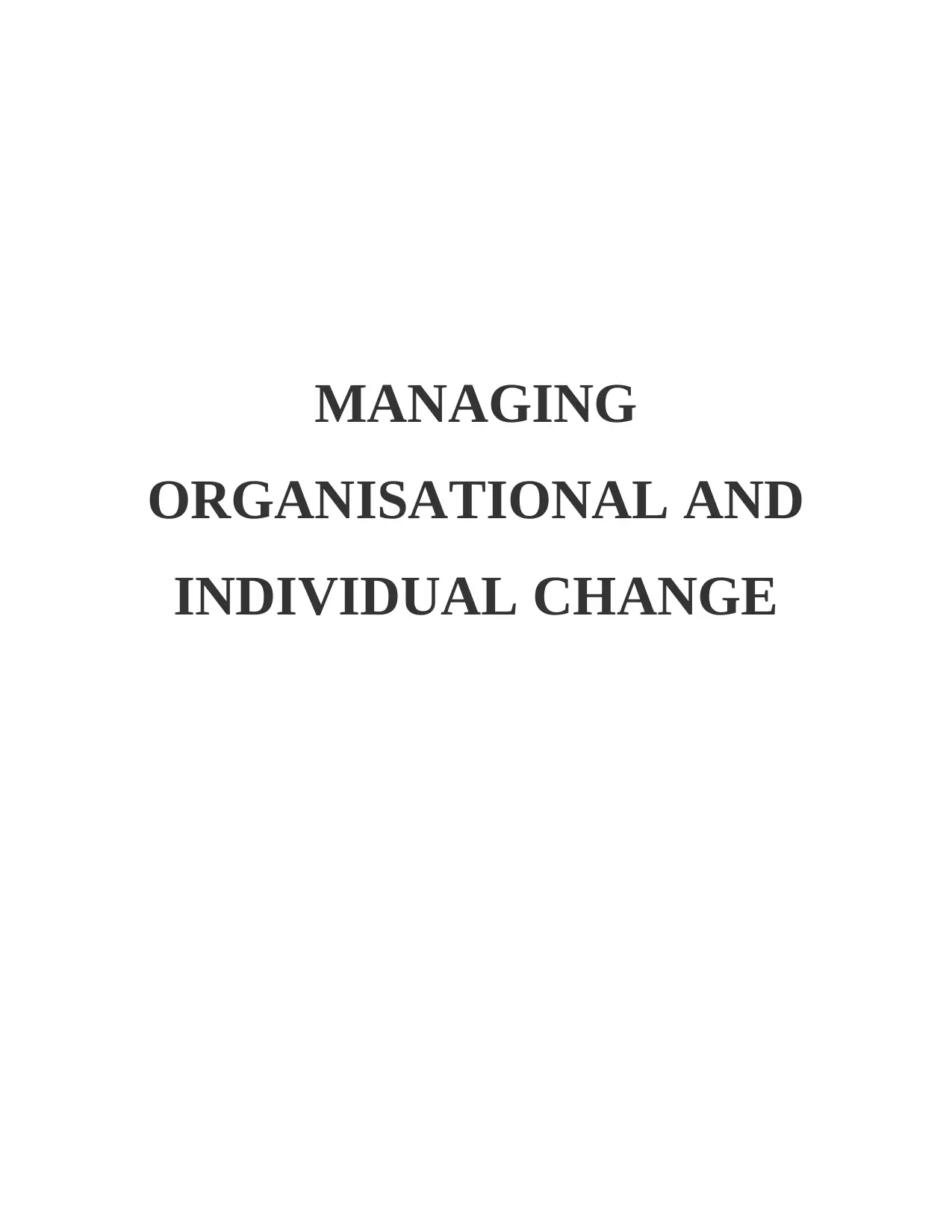
MANAGING
ORGANISATIONAL AND
INDIVIDUAL CHANGE
ORGANISATIONAL AND
INDIVIDUAL CHANGE
Paraphrase This Document
Need a fresh take? Get an instant paraphrase of this document with our AI Paraphraser
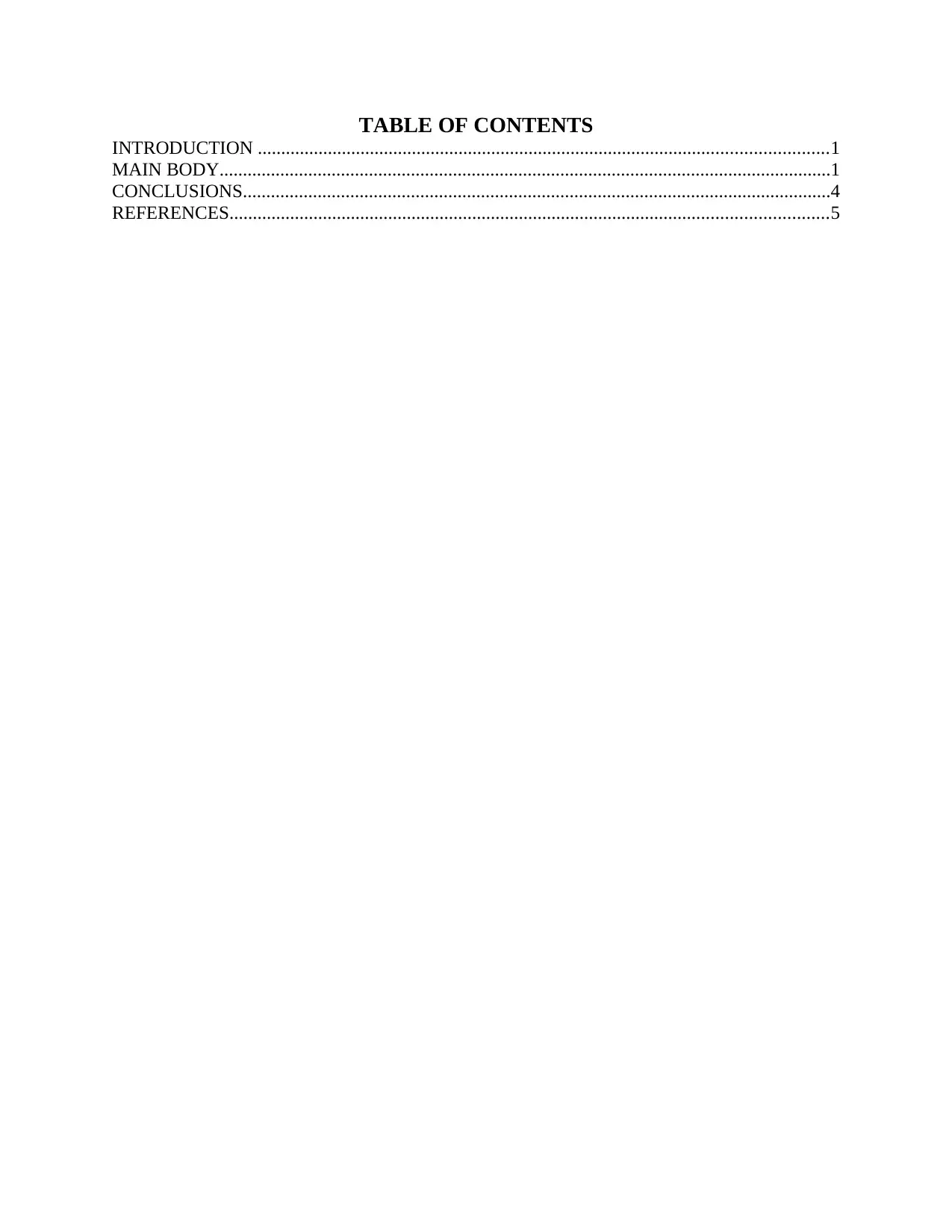
TABLE OF CONTENTS
INTRODUCTION ..........................................................................................................................1
MAIN BODY...................................................................................................................................1
CONCLUSIONS..............................................................................................................................4
REFERENCES................................................................................................................................5
INTRODUCTION ..........................................................................................................................1
MAIN BODY...................................................................................................................................1
CONCLUSIONS..............................................................................................................................4
REFERENCES................................................................................................................................5
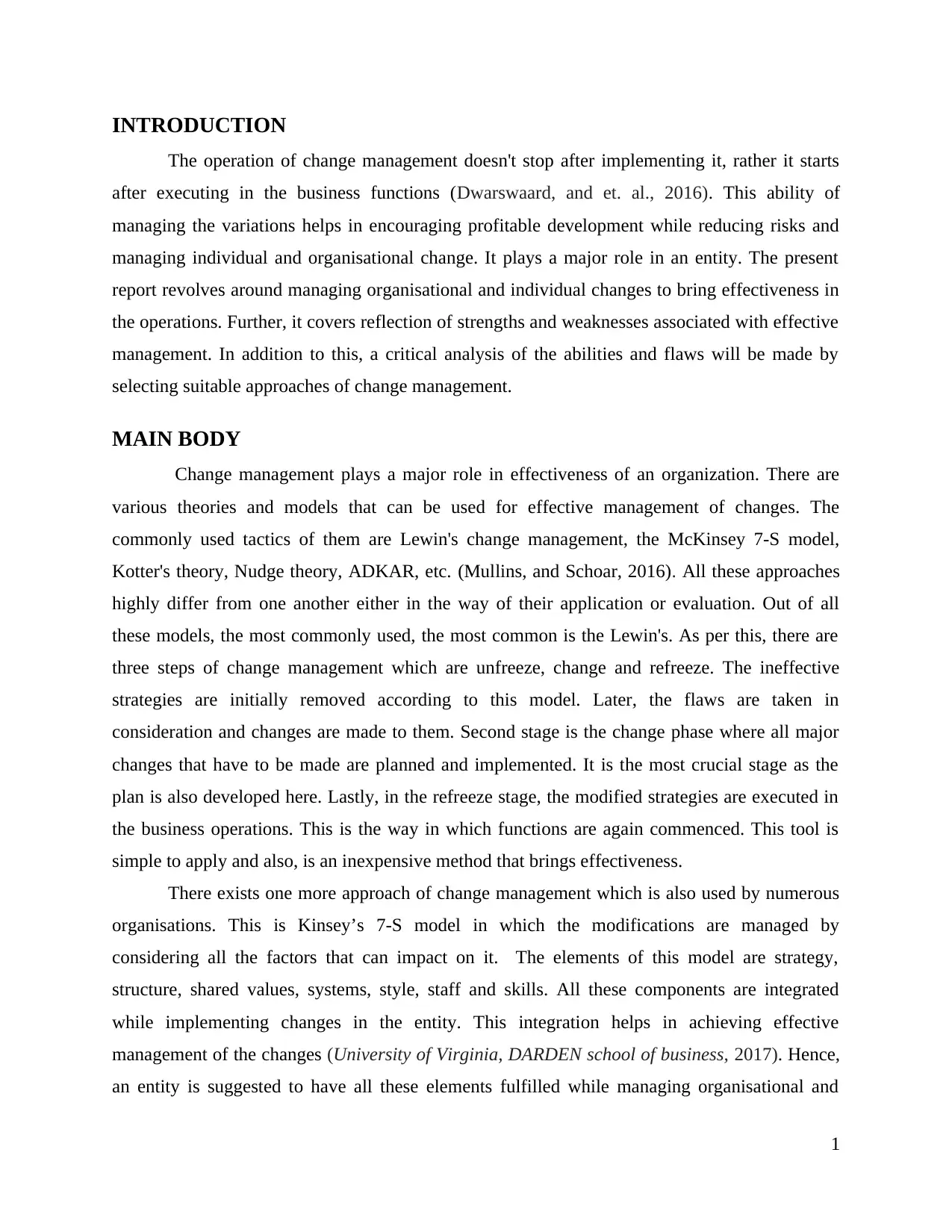
INTRODUCTION
The operation of change management doesn't stop after implementing it, rather it starts
after executing in the business functions (Dwarswaard, and et. al., 2016). This ability of
managing the variations helps in encouraging profitable development while reducing risks and
managing individual and organisational change. It plays a major role in an entity. The present
report revolves around managing organisational and individual changes to bring effectiveness in
the operations. Further, it covers reflection of strengths and weaknesses associated with effective
management. In addition to this, a critical analysis of the abilities and flaws will be made by
selecting suitable approaches of change management.
MAIN BODY
Change management plays a major role in effectiveness of an organization. There are
various theories and models that can be used for effective management of changes. The
commonly used tactics of them are Lewin's change management, the McKinsey 7-S model,
Kotter's theory, Nudge theory, ADKAR, etc. (Mullins, and Schoar, 2016). All these approaches
highly differ from one another either in the way of their application or evaluation. Out of all
these models, the most commonly used, the most common is the Lewin's. As per this, there are
three steps of change management which are unfreeze, change and refreeze. The ineffective
strategies are initially removed according to this model. Later, the flaws are taken in
consideration and changes are made to them. Second stage is the change phase where all major
changes that have to be made are planned and implemented. It is the most crucial stage as the
plan is also developed here. Lastly, in the refreeze stage, the modified strategies are executed in
the business operations. This is the way in which functions are again commenced. This tool is
simple to apply and also, is an inexpensive method that brings effectiveness.
There exists one more approach of change management which is also used by numerous
organisations. This is Kinsey’s 7-S model in which the modifications are managed by
considering all the factors that can impact on it. The elements of this model are strategy,
structure, shared values, systems, style, staff and skills. All these components are integrated
while implementing changes in the entity. This integration helps in achieving effective
management of the changes (University of Virginia, DARDEN school of business, 2017). Hence,
an entity is suggested to have all these elements fulfilled while managing organisational and
1
The operation of change management doesn't stop after implementing it, rather it starts
after executing in the business functions (Dwarswaard, and et. al., 2016). This ability of
managing the variations helps in encouraging profitable development while reducing risks and
managing individual and organisational change. It plays a major role in an entity. The present
report revolves around managing organisational and individual changes to bring effectiveness in
the operations. Further, it covers reflection of strengths and weaknesses associated with effective
management. In addition to this, a critical analysis of the abilities and flaws will be made by
selecting suitable approaches of change management.
MAIN BODY
Change management plays a major role in effectiveness of an organization. There are
various theories and models that can be used for effective management of changes. The
commonly used tactics of them are Lewin's change management, the McKinsey 7-S model,
Kotter's theory, Nudge theory, ADKAR, etc. (Mullins, and Schoar, 2016). All these approaches
highly differ from one another either in the way of their application or evaluation. Out of all
these models, the most commonly used, the most common is the Lewin's. As per this, there are
three steps of change management which are unfreeze, change and refreeze. The ineffective
strategies are initially removed according to this model. Later, the flaws are taken in
consideration and changes are made to them. Second stage is the change phase where all major
changes that have to be made are planned and implemented. It is the most crucial stage as the
plan is also developed here. Lastly, in the refreeze stage, the modified strategies are executed in
the business operations. This is the way in which functions are again commenced. This tool is
simple to apply and also, is an inexpensive method that brings effectiveness.
There exists one more approach of change management which is also used by numerous
organisations. This is Kinsey’s 7-S model in which the modifications are managed by
considering all the factors that can impact on it. The elements of this model are strategy,
structure, shared values, systems, style, staff and skills. All these components are integrated
while implementing changes in the entity. This integration helps in achieving effective
management of the changes (University of Virginia, DARDEN school of business, 2017). Hence,
an entity is suggested to have all these elements fulfilled while managing organisational and
1
⊘ This is a preview!⊘
Do you want full access?
Subscribe today to unlock all pages.

Trusted by 1+ million students worldwide
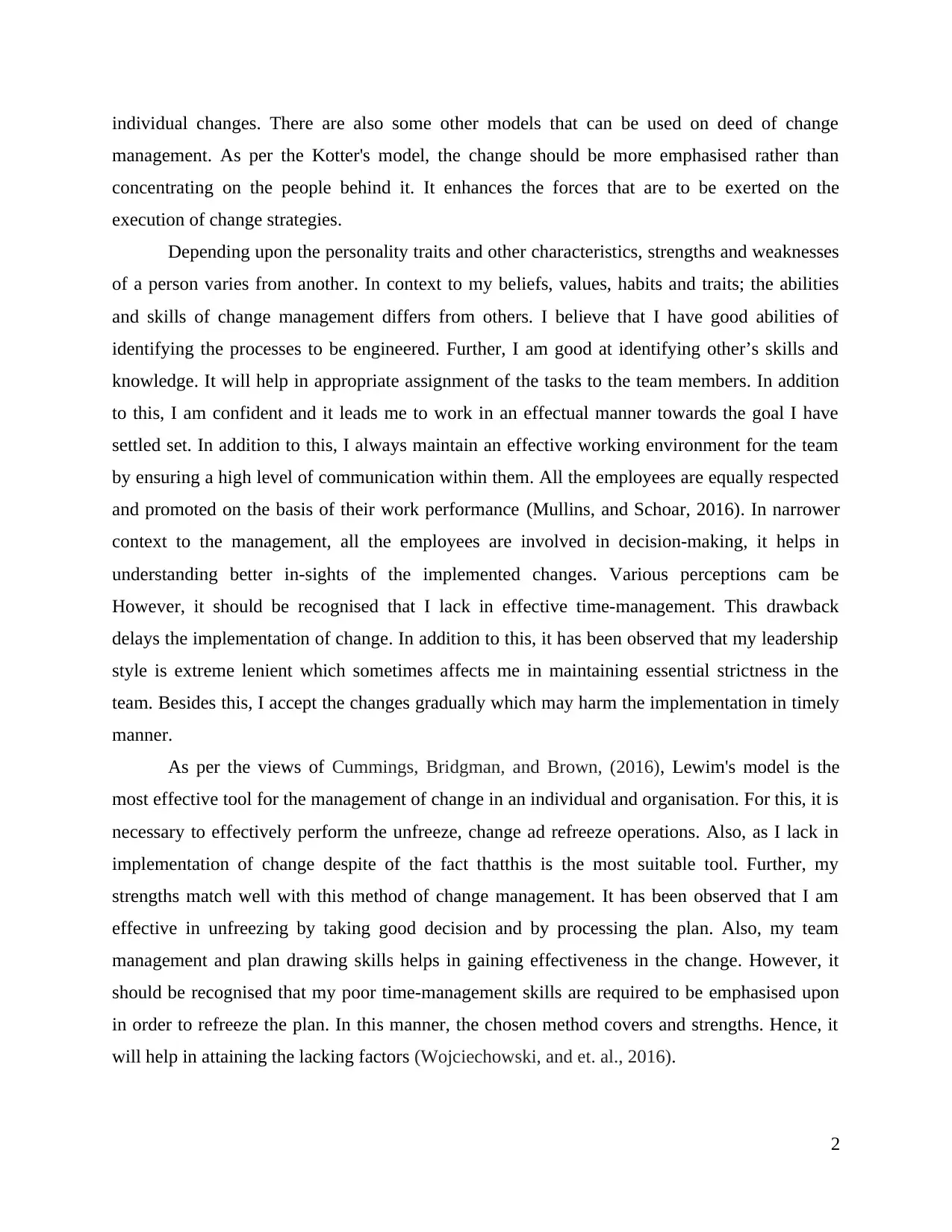
individual changes. There are also some other models that can be used on deed of change
management. As per the Kotter's model, the change should be more emphasised rather than
concentrating on the people behind it. It enhances the forces that are to be exerted on the
execution of change strategies.
Depending upon the personality traits and other characteristics, strengths and weaknesses
of a person varies from another. In context to my beliefs, values, habits and traits; the abilities
and skills of change management differs from others. I believe that I have good abilities of
identifying the processes to be engineered. Further, I am good at identifying other’s skills and
knowledge. It will help in appropriate assignment of the tasks to the team members. In addition
to this, I am confident and it leads me to work in an effectual manner towards the goal I have
settled set. In addition to this, I always maintain an effective working environment for the team
by ensuring a high level of communication within them. All the employees are equally respected
and promoted on the basis of their work performance (Mullins, and Schoar, 2016). In narrower
context to the management, all the employees are involved in decision-making, it helps in
understanding better in-sights of the implemented changes. Various perceptions cam be
However, it should be recognised that I lack in effective time-management. This drawback
delays the implementation of change. In addition to this, it has been observed that my leadership
style is extreme lenient which sometimes affects me in maintaining essential strictness in the
team. Besides this, I accept the changes gradually which may harm the implementation in timely
manner.
As per the views of Cummings, Bridgman, and Brown, (2016), Lewim's model is the
most effective tool for the management of change in an individual and organisation. For this, it is
necessary to effectively perform the unfreeze, change ad refreeze operations. Also, as I lack in
implementation of change despite of the fact thatthis is the most suitable tool. Further, my
strengths match well with this method of change management. It has been observed that I am
effective in unfreezing by taking good decision and by processing the plan. Also, my team
management and plan drawing skills helps in gaining effectiveness in the change. However, it
should be recognised that my poor time-management skills are required to be emphasised upon
in order to refreeze the plan. In this manner, the chosen method covers and strengths. Hence, it
will help in attaining the lacking factors (Wojciechowski, and et. al., 2016).
2
management. As per the Kotter's model, the change should be more emphasised rather than
concentrating on the people behind it. It enhances the forces that are to be exerted on the
execution of change strategies.
Depending upon the personality traits and other characteristics, strengths and weaknesses
of a person varies from another. In context to my beliefs, values, habits and traits; the abilities
and skills of change management differs from others. I believe that I have good abilities of
identifying the processes to be engineered. Further, I am good at identifying other’s skills and
knowledge. It will help in appropriate assignment of the tasks to the team members. In addition
to this, I am confident and it leads me to work in an effectual manner towards the goal I have
settled set. In addition to this, I always maintain an effective working environment for the team
by ensuring a high level of communication within them. All the employees are equally respected
and promoted on the basis of their work performance (Mullins, and Schoar, 2016). In narrower
context to the management, all the employees are involved in decision-making, it helps in
understanding better in-sights of the implemented changes. Various perceptions cam be
However, it should be recognised that I lack in effective time-management. This drawback
delays the implementation of change. In addition to this, it has been observed that my leadership
style is extreme lenient which sometimes affects me in maintaining essential strictness in the
team. Besides this, I accept the changes gradually which may harm the implementation in timely
manner.
As per the views of Cummings, Bridgman, and Brown, (2016), Lewim's model is the
most effective tool for the management of change in an individual and organisation. For this, it is
necessary to effectively perform the unfreeze, change ad refreeze operations. Also, as I lack in
implementation of change despite of the fact thatthis is the most suitable tool. Further, my
strengths match well with this method of change management. It has been observed that I am
effective in unfreezing by taking good decision and by processing the plan. Also, my team
management and plan drawing skills helps in gaining effectiveness in the change. However, it
should be recognised that my poor time-management skills are required to be emphasised upon
in order to refreeze the plan. In this manner, the chosen method covers and strengths. Hence, it
will help in attaining the lacking factors (Wojciechowski, and et. al., 2016).
2
Paraphrase This Document
Need a fresh take? Get an instant paraphrase of this document with our AI Paraphraser
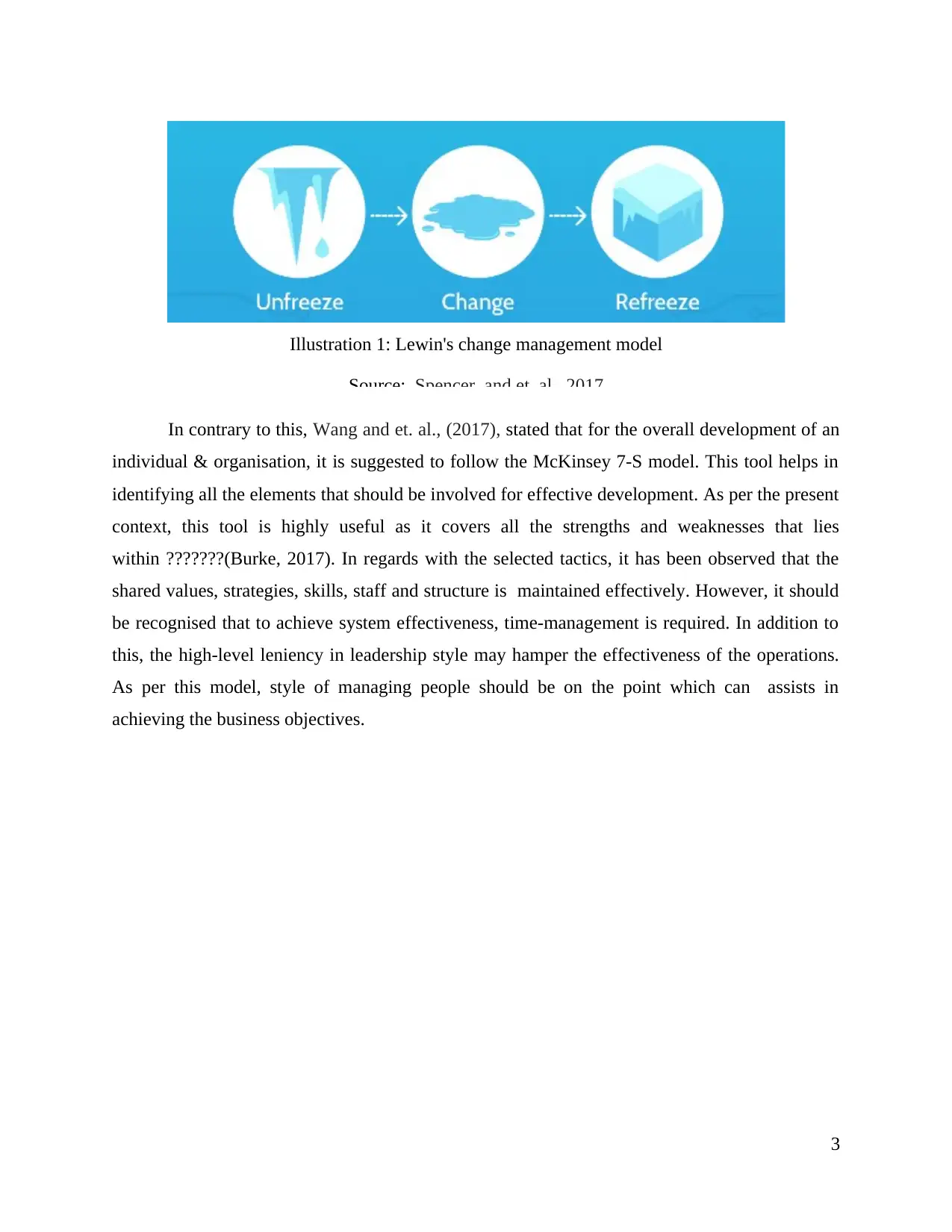
In contrary to this, Wang and et. al., (2017), stated that for the overall development of an
individual & organisation, it is suggested to follow the McKinsey 7-S model. This tool helps in
identifying all the elements that should be involved for effective development. As per the present
context, this tool is highly useful as it covers all the strengths and weaknesses that lies
within ???????(Burke, 2017). In regards with the selected tactics, it has been observed that the
shared values, strategies, skills, staff and structure is maintained effectively. However, it should
be recognised that to achieve system effectiveness, time-management is required. In addition to
this, the high-level leniency in leadership style may hamper the effectiveness of the operations.
As per this model, style of managing people should be on the point which can assists in
achieving the business objectives.
3
Illustration 1: Lewin's change management model
Source: Spencer, and et. al., 2017
individual & organisation, it is suggested to follow the McKinsey 7-S model. This tool helps in
identifying all the elements that should be involved for effective development. As per the present
context, this tool is highly useful as it covers all the strengths and weaknesses that lies
within ???????(Burke, 2017). In regards with the selected tactics, it has been observed that the
shared values, strategies, skills, staff and structure is maintained effectively. However, it should
be recognised that to achieve system effectiveness, time-management is required. In addition to
this, the high-level leniency in leadership style may hamper the effectiveness of the operations.
As per this model, style of managing people should be on the point which can assists in
achieving the business objectives.
3
Illustration 1: Lewin's change management model
Source: Spencer, and et. al., 2017
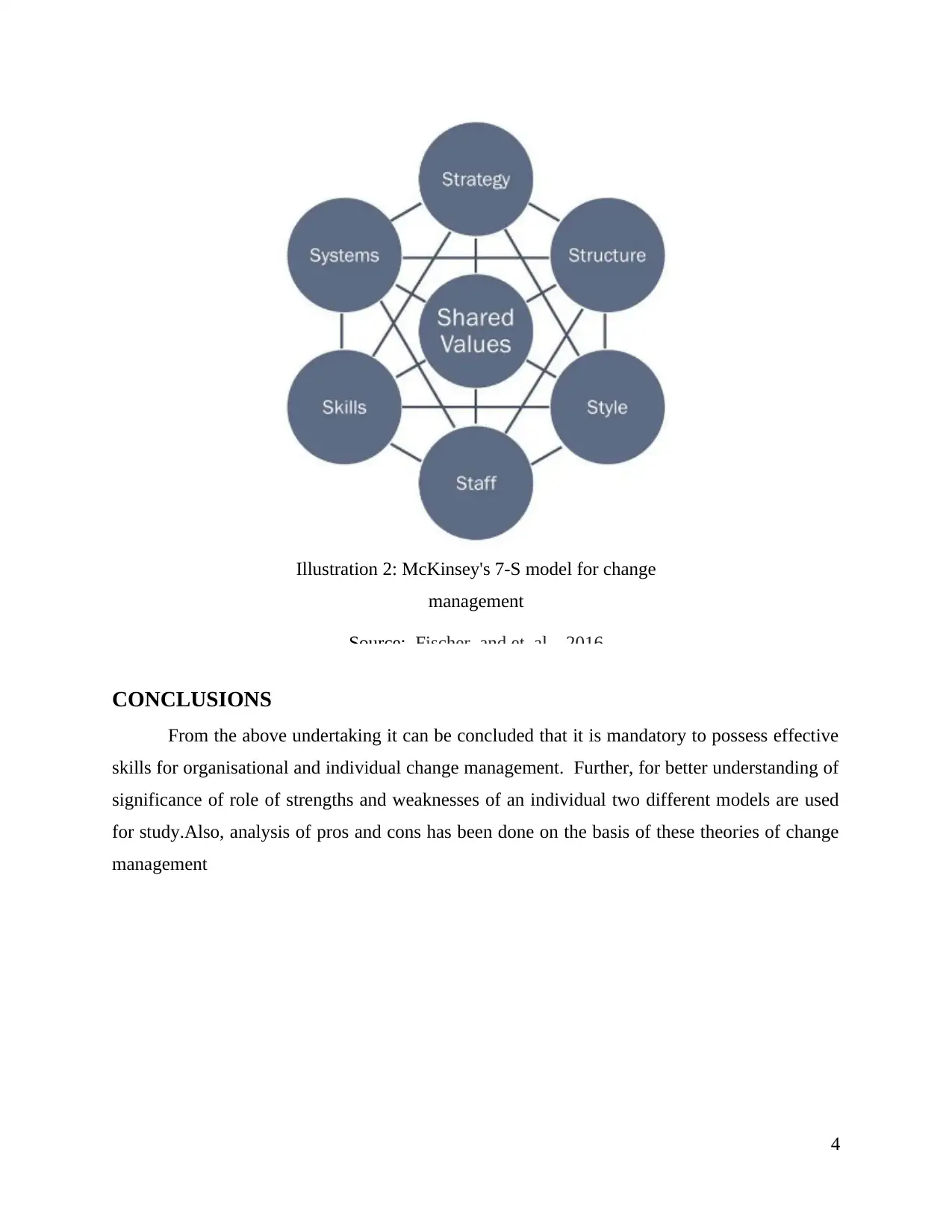
CONCLUSIONS
From the above undertaking it can be concluded that it is mandatory to possess effective
skills for organisational and individual change management. Further, for better understanding of
significance of role of strengths and weaknesses of an individual two different models are used
for study.Also, analysis of pros and cons has been done on the basis of these theories of change
management
4
Illustration 2: McKinsey's 7-S model for change
management
Source: Fischer, and et. al., 2016
From the above undertaking it can be concluded that it is mandatory to possess effective
skills for organisational and individual change management. Further, for better understanding of
significance of role of strengths and weaknesses of an individual two different models are used
for study.Also, analysis of pros and cons has been done on the basis of these theories of change
management
4
Illustration 2: McKinsey's 7-S model for change
management
Source: Fischer, and et. al., 2016
⊘ This is a preview!⊘
Do you want full access?
Subscribe today to unlock all pages.

Trusted by 1+ million students worldwide
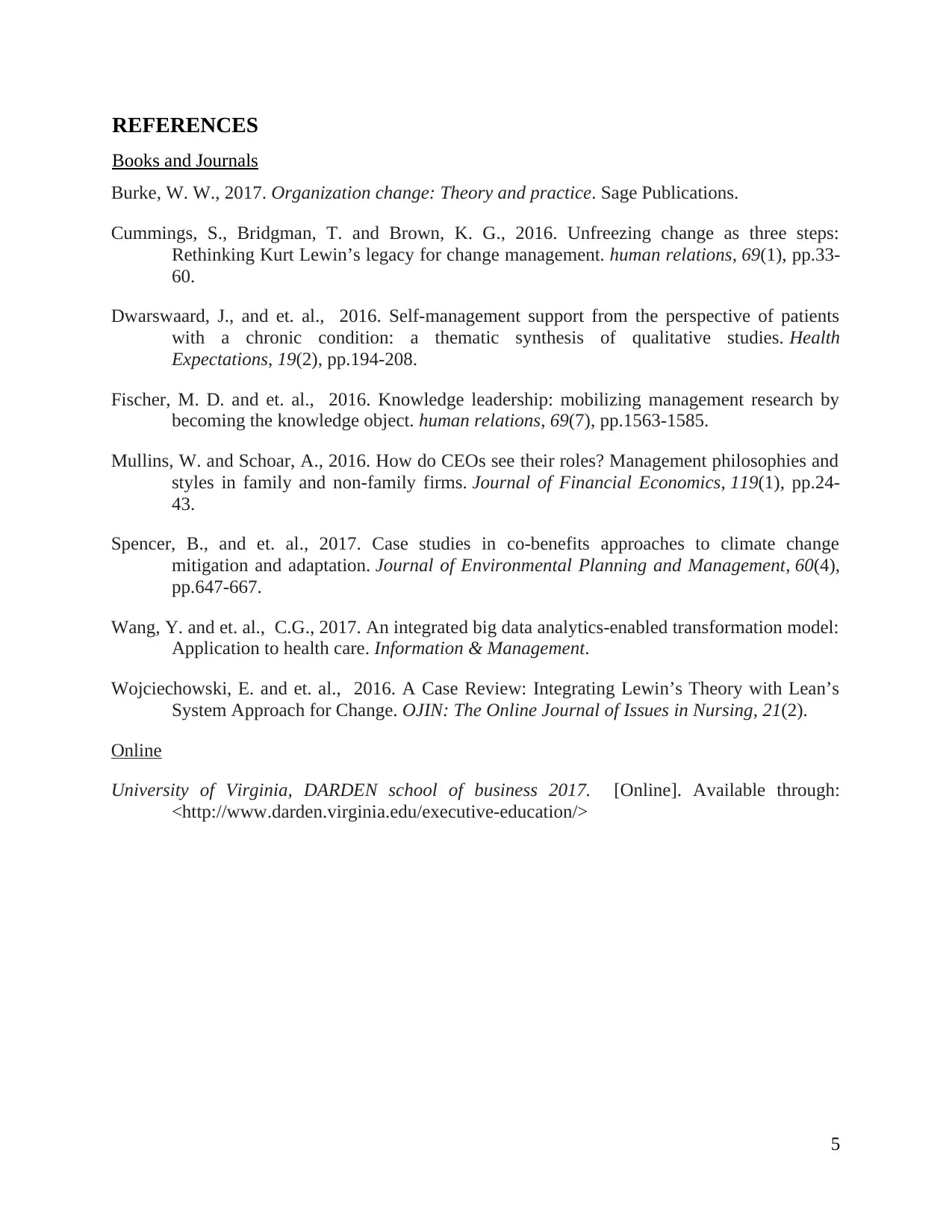
REFERENCES
Books and Journals
Burke, W. W., 2017. Organization change: Theory and practice. Sage Publications.
Cummings, S., Bridgman, T. and Brown, K. G., 2016. Unfreezing change as three steps:
Rethinking Kurt Lewin’s legacy for change management. human relations, 69(1), pp.33-
60.
Dwarswaard, J., and et. al., 2016. Self‐management support from the perspective of patients
with a chronic condition: a thematic synthesis of qualitative studies. Health
Expectations, 19(2), pp.194-208.
Fischer, M. D. and et. al., 2016. Knowledge leadership: mobilizing management research by
becoming the knowledge object. human relations, 69(7), pp.1563-1585.
Mullins, W. and Schoar, A., 2016. How do CEOs see their roles? Management philosophies and
styles in family and non-family firms. Journal of Financial Economics, 119(1), pp.24-
43.
Spencer, B., and et. al., 2017. Case studies in co-benefits approaches to climate change
mitigation and adaptation. Journal of Environmental Planning and Management, 60(4),
pp.647-667.
Wang, Y. and et. al., C.G., 2017. An integrated big data analytics-enabled transformation model:
Application to health care. Information & Management.
Wojciechowski, E. and et. al., 2016. A Case Review: Integrating Lewin’s Theory with Lean’s
System Approach for Change. OJIN: The Online Journal of Issues in Nursing, 21(2).
Online
University of Virginia, DARDEN school of business 2017. [Online]. Available through:
<http://www.darden.virginia.edu/executive-education/>
5
Books and Journals
Burke, W. W., 2017. Organization change: Theory and practice. Sage Publications.
Cummings, S., Bridgman, T. and Brown, K. G., 2016. Unfreezing change as three steps:
Rethinking Kurt Lewin’s legacy for change management. human relations, 69(1), pp.33-
60.
Dwarswaard, J., and et. al., 2016. Self‐management support from the perspective of patients
with a chronic condition: a thematic synthesis of qualitative studies. Health
Expectations, 19(2), pp.194-208.
Fischer, M. D. and et. al., 2016. Knowledge leadership: mobilizing management research by
becoming the knowledge object. human relations, 69(7), pp.1563-1585.
Mullins, W. and Schoar, A., 2016. How do CEOs see their roles? Management philosophies and
styles in family and non-family firms. Journal of Financial Economics, 119(1), pp.24-
43.
Spencer, B., and et. al., 2017. Case studies in co-benefits approaches to climate change
mitigation and adaptation. Journal of Environmental Planning and Management, 60(4),
pp.647-667.
Wang, Y. and et. al., C.G., 2017. An integrated big data analytics-enabled transformation model:
Application to health care. Information & Management.
Wojciechowski, E. and et. al., 2016. A Case Review: Integrating Lewin’s Theory with Lean’s
System Approach for Change. OJIN: The Online Journal of Issues in Nursing, 21(2).
Online
University of Virginia, DARDEN school of business 2017. [Online]. Available through:
<http://www.darden.virginia.edu/executive-education/>
5
Paraphrase This Document
Need a fresh take? Get an instant paraphrase of this document with our AI Paraphraser

6
1 out of 8
Related Documents
Your All-in-One AI-Powered Toolkit for Academic Success.
+13062052269
info@desklib.com
Available 24*7 on WhatsApp / Email
![[object Object]](/_next/static/media/star-bottom.7253800d.svg)
Unlock your academic potential
Copyright © 2020–2025 A2Z Services. All Rights Reserved. Developed and managed by ZUCOL.




